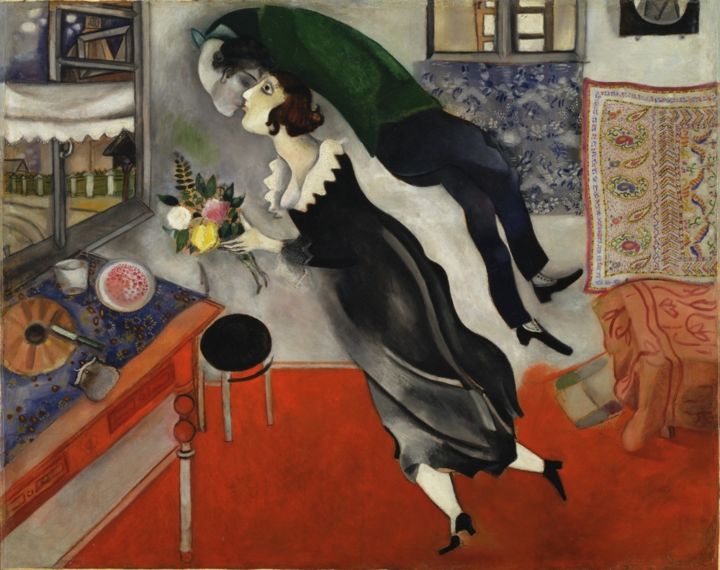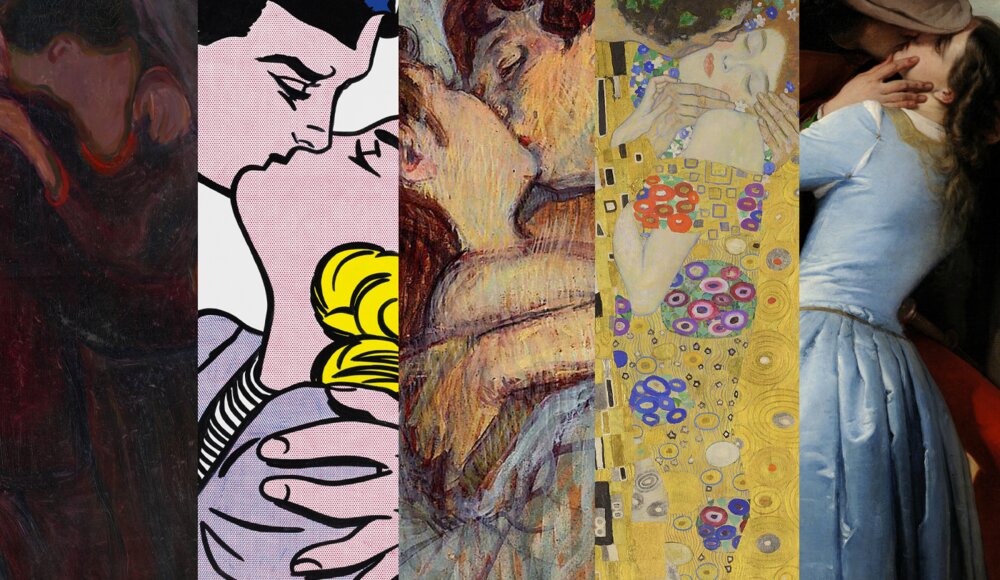
Valentine's Day is coming soon, let's take this opportunity to come back to the most languorous kisses in the History of Art. From the ancient and no less famous mythological scenes of the Renaissance to the very contemporary stencils of street artist Banksy, the impulse and the embrace of love have always been the inspiration of artists, as painters, sculptors or photographers.
8. Francesco Hayez: the darkest one

Francesco Hayez, The Kiss, 1859. Pinacoteca di Brera, Milan.
The oldest work in this ranking is signed Francesco Hayez, a famous figure of Italian Romanticism. In this artwork, we discover a couple embracing each other in the center of the canvas, as if they were one. Around them, shadows dominate, we even guess the silhouette of an elderly woman on the left side, from behind, going down the stairs. This fiery kiss seems to be stolen, carried out in secret and in haste, these young lovers enjoying a short moment of calm away from reproving gazes. Deeply against the standards of decency applied at the time, this representation of the fiery kiss by Hayez was the object of many interpretations: it is thus considered as a symbol of the Italian unification (Risorgimento) very divided at the time, and even as an allegory of the alliance between France and Italy, these two nations having signed a pact in 1859, year of realization of this artwork.
7. Auguste Rodin: the most electric

Auguste Rodin, The Kiss, 1889. Rodin Museum, Paris.
It is difficult to list the most popular embraces in the History of Art without evoking Auguste Rodin's The Kiss. This monumental marble sculpture was made at the request of the French government, as part of the 1900 Paris Exposition. It's not the only timeless artwork from this international cultural event, since the legendary Eiffel Tower was also built for the occasion.
This fiery intertwining is inspired by the poem The Divine Comedy by Dante. It represents Francesca da Rimini and her brother-in-law Paolo Malatesta, with whom she fell madly in love. The two lovers were murdered by Francesca's husband, after he caught them reading together the adventures of Lancelot and Queen Genever (they too were ardent lovers). The book can be seen on the statue of Rodin, in Paolo's left hand. This adultery condemned them to wander in Heaven, but their powerful love will remain forever engraved in the rock thanks to the creative genius of Auguste Rodin.
6. Henri de Toulouse-Lautrec: The Proudest

Henri de Toulouse-Lautrec, Dans le Lit, Le Baiser, 1892. Private collection.
What we like about Toulouse-Lautrec is the raw truth that emerges from his entire work. Emblematic painter of the bohemian life and the frivolous Parisian microcosm of the end of the 19th century, he devoted his life to his art. Until his untimely death at the age of 37, he explored the more or less well frequented establishments of the Pigalle district and its Moulin Rouge, from drinking establishments to dancing cabarets, including brothels. It's in one of these that he realized this carnal and affectionate kiss. Don't let the short hair of the character on the right mislead you: far from an androgynous masculinity, these are two women that we discover passionately embracing each other. The choice of such a composition at such a hetero-normative time, mixed with a high quality craftsmanship of which only Toulouse-Lautrec had the secret, made this artwork the masterpiece we now know.
5. René Magritte: the most disturbing

René Magritte, Les Amants I, 1928. Museum of Modern Art, New York.
This famous painting by René Magritte, who became a pictorial icon of the coronavirus crisis, is the first of a series of 4 paintings entitled The Lovers, and numbered from I to IV. Very inspired by his surrealist Parisian friendships (Dali, Ernst, Breton...), Magritte presents here a couple embraced with their faces camouflaged by two white textiles. Behind them, we discover a very pure interior, focusing all the attention of the spectator on this mysterious feverish kiss. The white cloths deprive the lovers of different senses, which are usually necessary during an embrace: sight, touch, but also smell, hearing and taste are annihilated by these strange veils imprisoning the faces of these two lovebirds. This set of misunderstandings obviously brings with it its anthology of divergent interpretations: representation of an unconscious desire? hymn to blind love? to the discretion of emotions (to live happily, let's live hidden)? René Magritte, in the pure vein of surrealism, won't bring any explanation to this composition, leaving to the most sensible observers a wide and mysterious field of interpretation, as pleasant for the eyes as stimulating for the mind.
4. Edvard Munch: The most fusional

Edvard Munch, Kissing at the Window, 1897. Munch Museum, Oslo.
The most famous Norwegian painter, Edvard Munch, offers us a dark and uncompromising artwork. This oil on canvas painted in 1897 is part of a series entitled The Frieze of Life, which the Symbolist painter continued to enrich for almost 30 years. This series was intended to illustrate the different stages of development of a relationship between a man and a woman, what Munch himself called "the battle between the man and the woman we call love".
This painting cannot be interpreted without context, without knowing the tragic life trajectory of its author. Indeed, throughout his career, Edvard Munch had to deal with illness (both physical and mental), a rigid and fanatical father, many deaths among his loved ones, as well as numerous love disappointments and recurring alcoholism crises. All these elements strongly influenced his artistic production, and the emotions that flowed from it. In this artwork, we see a couple in the dark, embracing each other in such a fusional way that their faces eventually merge into one formless task. This composition bitterly testifies to Edvard Munch's ambivalence about idyll, passion in love. One can analyze in this mixture of faces the fusional unity of a couple, just as it is possible to understand the loss of individuality resulting from this absorption, loss of one's own existence and identity, thus fatally approaching death.
3. Constantin Brancusi : The most eternal

Constantin Brancusi, The Kiss, 1905-1910. Montparnasse Cemetery, Paris.
Here is an artwork with a destiny as romantic as tragic. The Kiss, by the Franco-Romanian artist Brancusi, is a series of forty sculptures created from 1905 onwards. These sculptures start from common intentions: simplification of form, geometric intertwining, fusion of beings... However, they are also distinct, not being made in series from the same mold, but by the artist himself, who modified certain attributes of his sculptures during his creative process.
One of them decorates, still today, the tomb of a young woman in Montparnasse cemetery in Paris. In 1910, a young Russian exiled named Tatiana Rachewskaya committed suicide. Her parents, inconsolable, decided to order from Constantin Brancusi, still unknown at the time (but a disciple of the illustrious Rodin), a large statue to install on the grave of their dead daughter. Very sensitive to this dramatic story, the sculptor decided to install a very particular version of The Kiss on the girl's grave. 90cm high, he thus created the largest statue of this long series, the only sculpture where the lovers are discovered on their full feet, in their entirety. Today, more than 100 years after these events, the value of the artist's work has exploded: this sculpture is now estimated at several tens million euros, and the poetry of this tragedy is fading away. The heirs of the deceased want to recover this sculpture, which they consider to be their own, but the French state is firmly opposed to this, considering this artwork to be a historical monument.
Spoliation for some, conservation of a historical heritage for others, the debates remain open and the legal crusade has only just begun. Since one tragedy can hide another, we can no longer contemplate this artwork, which is now covered with a wooden box (to protect it from natural hazards and pollution), and constantly monitored by numerous cameras.
2. Marc Chagall: the most surrealist

Marc Chagall, The Anniversary, 1915. Museum of Modern Art, New York.
In this intensely poetic and surrealist artwork, the Belarusian-born artist takes us into one of his dreams. It depicts a couple, Marc Chagall and his partner, Bella, embracing in a position defying the laws of gravity as we know them. The painter shows us that for him, far from being a simple expression, love really gives wings. When he creates this painting, he has just come out of a long period of separation from his beloved, his youthful love, which he has just found again and whose hand he has asked for. During all this happy period, he will not cease to paint himself with his feet detached from the ground, floating in different dreamlike and childlike universes. In this artwork, everything is fantasy: the rules of perspective are abandoned to give way to pictorial euphoria: the floor is bright red, the table has only one foot, the objects placed on it, yet fixed, seem to be tilting towards the fall...
1. Gustav Klimt : The most iconic

Gustav Klimt, The Kiss, 1909. Belvedere Palace, Vienna.
Gustav Klimt's Kiss is without a doubt the most eloquent loving embrace in the entire History of Art. In a very particular style that only Klimt has the secret, we discover a couple, on full feet, covered with gilded and ornamented fineries. The Man delicately kisses his suitor on the cheek, while she embraces him and abandons herself to him. All around them, a natural freshness arouses seduction: from the field of multicolored flowers, to the floral patterns covering the female figure's dress, until the ivy crown adorning her suitor's head, everything seems to converge to fix forever the extraordinary poetry of this scene.
But who are these lovers?
For some, it' s simply an illustration of the artist and his girlfriend, Emilie Flöge. For others, it is rather a mythological allegory representing the moment when Apollo kisses the nymph Daphne, who will then metamorphose into a laurel tree to escape from the God of Arts and Beauty.
And there it is, the end of this classification overflowing with devotion and enthusiasm. We hope you enjoyed this selection as much as it was enjoyable to write, and we wish you a pleasant Valentine's Day.
For the greatest admirers of passionate liaisons and fine art, we recommend you to discover our selection of artworks celebrating romance: love at first sight guaranteed!
Bastien Alleaume
Content Manager - Artmajeur Online Art Gallery



 Bastien Alleaume
Bastien Alleaume